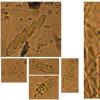
20-12-2025 23:08
Patrice TANCHAUDBonsoir, récolte sur sol sablonneux dans l'arri�

21-12-2025 09:32
Hello.A tiny ascomycete found embedded in wood in

20-12-2025 15:47
Mirek GrycHi.These grew on pine wood that was heavily covere

18-12-2025 21:17
Pol DebaenstThe identification took me to Byssonectria deformi

15-12-2025 07:09
 Danny Newman
Danny Newman
indet. Rutstroemiaceae sp. on unk. fallen leavesMc

19-12-2025 10:10
Patrice TANCHAUDBonjour, récolte réalisée en milieu dunaire, a

18-12-2025 17:23
 Bruno Coué
Bruno Coué
Bonjour,je serais heureux d'avoir votre avis sur c
 Dear friends
Dear friendsAmong the old samples, which are stored in our mycological collection, I found one that was signed as Nectria decora. It is not N. decora a 100% and even non Nectriaceae representative, because presence of many threadlike, branched, septate paraphyses (pseudoparaphyses) in hamathecium.
Perithecia (pseudothecia) erupt in dense groups from the bark of thin dry twigs of Caranana arorescens. Externally perithecia looks olive-brown, but in a cross section the wall is clearly red-brown. The walls of fruiting are very thick. Asci are 67,3-83,6 x 14,2-15,8. Ascospores are arranged in two rows or obliquely, in some cases biseriate in the upper part and uniseriate below. Ascospores hyaline, muriform (with 7-8 transverse and multiple longitudinal and oblique septae), slightly constricted near the central septum, 16,3-21,5 x 4,7-7,6.
Alone I can not reidentify this sample.
If you have some ideas about it, I would greatly appreciate for your help.
Alex

Hello Alex,
this sample has transversely septate spores. So - I first would look in the genus Thyronectria. Maybe there ist a species on Caragana?
Regards from Lothar

This is really Thyronectria representative with presence of paraphyses in hamathecium.
New article about this genus is in the attached file.
Alex

thank you for the paper! - very interesting, I did not have it yet.
Maybe you can find a species there - or not?
Regards from Lothar

thank you for the paper! - very interesting, I did not have it yet.
Maybe you can find a species there - or not?
Regards from Lothar



 s10-0001.pdf
s10-0001.pdf